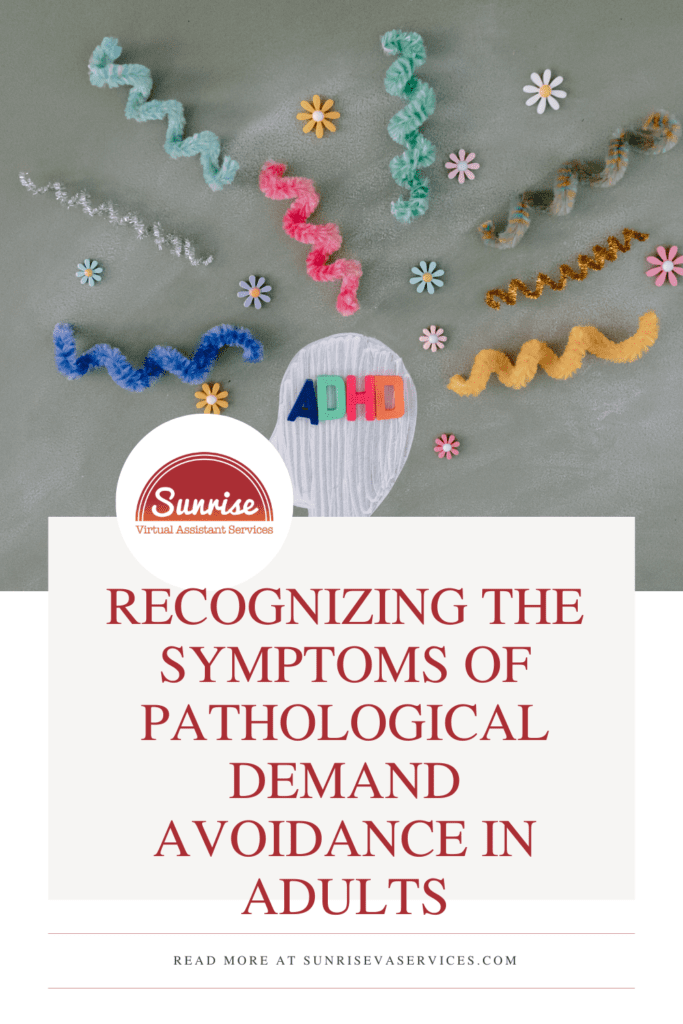Symptoms of pathological demand avoidance (PDA) are important to recognize, especially in adults. As a lesser-known condition within autism spectrum disorders, understanding PDA is crucial for neurodivergent individuals, small business owners, and entrepreneurs managing complex personal and professional challenges.
As fellow neurodivergent adults, we at Sunrise Virtual Assistant Services get it. And we do understand the struggles that come with identifying and managing unique challenges like PDA.
This article aims to shed light on the characteristics, real-life impacts, and strategies to manage PDA effectively.
Whether you’re exploring this for yourself, a colleague, or a loved one, understanding is the first step toward greater support and empowerment.
What Is Pathological Demand Avoidance (PDA)?
Pathological demand avoidance, often referred to as PDA, is a behavioral profile characterized by an extreme avoidance of everyday demands and expectations.
First introduced in the 1980s by Professor Elizabeth Newson, PDA has been recognized as a subtype of autism, featuring notable similarities while presenting unique challenges.
Unlike individuals with classic autism spectrum disorder (ASD), those with PDA use social strategies, such as role-play or humor, to avoid demands.
Pathological demand avoidance may sound unfamiliar, but it is actually quite common. Anecdotal reports suggest that PDA shows significant differences from other, more pervasive developmental disorders, such as autism and oppositional defiant disorder.
Key Differentiators
Autism Spectrum Disorder (ASD):
- Autistic individuals often struggle with social interaction, sensory overload, and repetitive behaviors.
- PDA shares high levels of anxiety and demand avoidance behaviors but incorporates a more pronounced use of social strategies to resist demands.
Oppositional Defiant Disorder (ODD):
- ODD involves willful defiance and oppositional behaviors directed at perceived authority figures.
- On the other hand, PDA stems from extreme anxiety rather than a deliberate act of defiance.
Prevalence and Recognition
While exact statistics are lacking in adults, the PDA profile can be identified across various settings. Tools like the extreme demand avoidance questionnaire (EDA-Q) assist healthcare professionals in understanding this particular behavioral profile.
Nonetheless, things can fall through the cracks, no matter how hard we try. PDA often goes unrecognized, resulting in many adults never obtaining a formal diagnosis, which leads to ongoing difficulties in adapting to both professional and personal environments.
Recognizing Symptoms of PDA in Adults
Understanding the common symptoms of PDA is the first step toward identification of PDA. Below are key symptoms, often exhibited to varying degrees in different people:
Avoidance Strategies
- Adults with PDA go to great lengths to avoid demands, even seemingly minor ones like replying to emails or attending meetings.
- Strategies include procrastination, role play, excessive questioning, or creating distractions.
Extreme Anxiety Linked to Ordinary Demands
- Daily tasks can cause significant anxiety for these people, leading to panic attacks, sensory overload, or flight responses.
- This anxiety stems from an intense need for a sense of control, or possibly regaining control.
Challenges with Authority Figures
- Adults with PDA often face challenges when it comes to adhering to rules set by authority figures, such as managers or clients.
- They may find ways to undermine authority to covertly regain their sense of control.
Social Communication Challenges
- Difficulty interpreting social cues, body language, or facial expressions can lead to strained social interactions.
- PDA behaviors may include overreliance on different strategies or an obsessive need to maintain certain routines within their social situations.
Obsessive Behaviors and Coping Mechanisms
- Adults with PDA often rely on obsessive behavior or hobbies as coping mechanisms to manage their anxiety.
Fictional Example
Imagine Joanna, a small business owner, who avoids responding to invoices because they make her feel overwhelmed.
Instead, she spends hours rearranging her office to regain a sense of control. Her employees see this as procrastination, but the root lies in her demand avoidance behaviors driven by anxiety.
Impact of PDA on Daily Life and Work
Pathological demand avoidance can have a significant impact on an adult’s daily life, particularly for business professionals and entrepreneurs.
Professional Challenges
PDA can cause difficulties in maintaining motivation and consistency in work schedules, meeting deadlines, and dealing with clients or authority figures.
Entrepreneurs with PDA may experience burnout from trying to meet everyday demands in different settings while battling their persistent drive to avoid them.
Relationships
Struggles in social skills and interpreting social cues can create misunderstandings with family members, colleagues, and friends.
Emotional Well-being
Anxiety and an overwhelming need for control can often lead to intense feelings of isolation, depression, and low self-esteem if they do not have the appropriate support.
Approaches to Recognizing PDA in Adults
The identification of PDA in adults requires awareness and a willingness to seek out professional help.
Here are steps to help recognize PDA traits:
- Self-awareness
Begin by observing patterns like extreme avoidance behaviors or recurring challenges in handling social situations. Reflection on these traits can be crucial in pinpointing whether PDA might be a factor.
- Professional Assessment
Seek a formal diagnosis from a mental health professional or specialist trained in PDA autism. Tools like the extreme demand avoidance questionnaire or assessments used in the National Autistic Society may provide clarity.
- Lean on Support Networks
Joining support groups or the PDA Society can connect you with individuals who understand the complexities of living with PDA.
Strategies for Managing PDA Symptoms
Once you’ve recognized PDA traits, integrating support strategies can significantly improve your quality of life. Here’s how:
At Work
- Collaborative Approach: Engage team members in creating a supportive environment where responsibilities are shared.
- Environmental Adjustments: Reduce triggers like bright lights and noise that may lead to sensory overload.
- Communication Techniques: Use written instructions instead of verbal, as this may reduce the pressure of immediate compliance.
At Home
- Role Play: Practice responses to demands in a low-pressure setting to ease anxiety in real scenarios.
- Flexibility in Routine: Allow room for adaptation while maintaining necessary structures.
Emotional Support
- Regular therapy sessions, including occupational therapy, can help you manage high anxiety levels and develop better-coping mechanisms.
Early Recognition and Support
Early recognition of the symptoms of Pathological Demand Avoidance in adults is essential for achieving positive outcomes. With appropriate support and intervention, adults can overcome their unique challenges and begin to thrive in social situations, professional settings, and personal relationships.
Resources and Support Networks
You’re not alone in this. Organizations like the National Autistic Society offer invaluable resources. Engaging with family members, healthcare professionals, and support teams can make a difference in ensuring lasting, positive outcomes.
Final Thoughts
Pathological demand avoidance is a behavioral profile that presents unique and complex challenges for adults, particularly in their daily lives and work environments.
By understanding the common symptoms of PDA and recognizing the behavioral profile associated with this condition, individuals can take the first steps toward seeking an accurate diagnosis and building a supportive network.
If you or someone you know identifies with the symptoms of Pathological Demand Avoidance, now is the time to take that step. Awareness fosters understanding, and understanding paves the way for acceptance. Together, we can create a world that embraces neurodivergent individuals for their unique needs and contributions.
Remember, support is out there—you are not in this alone.


